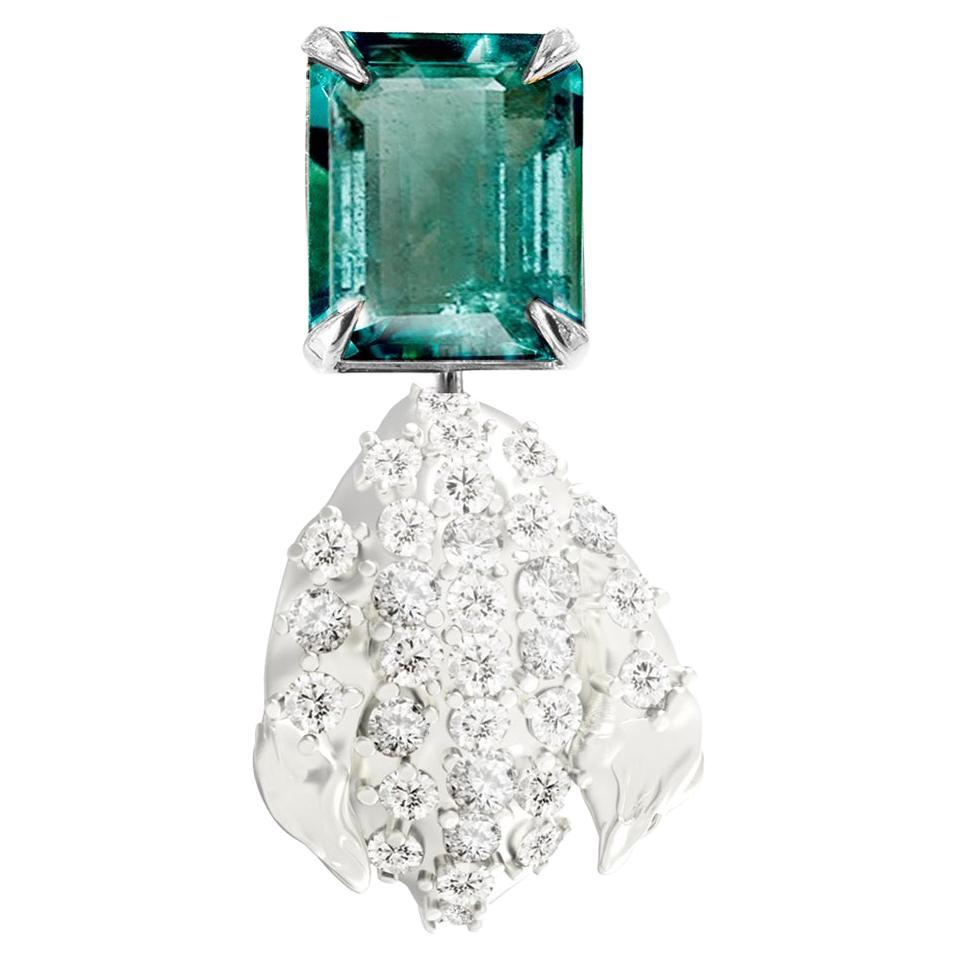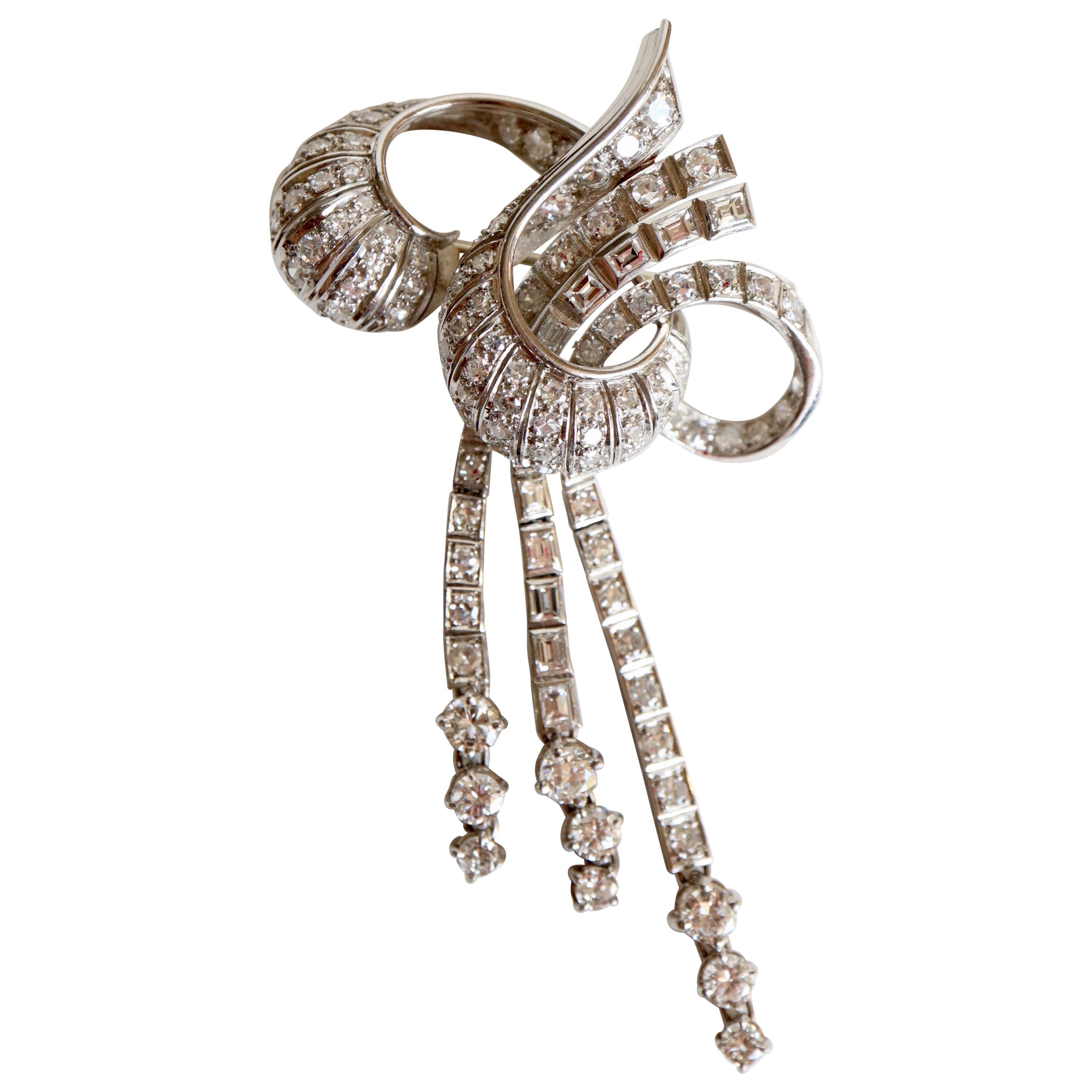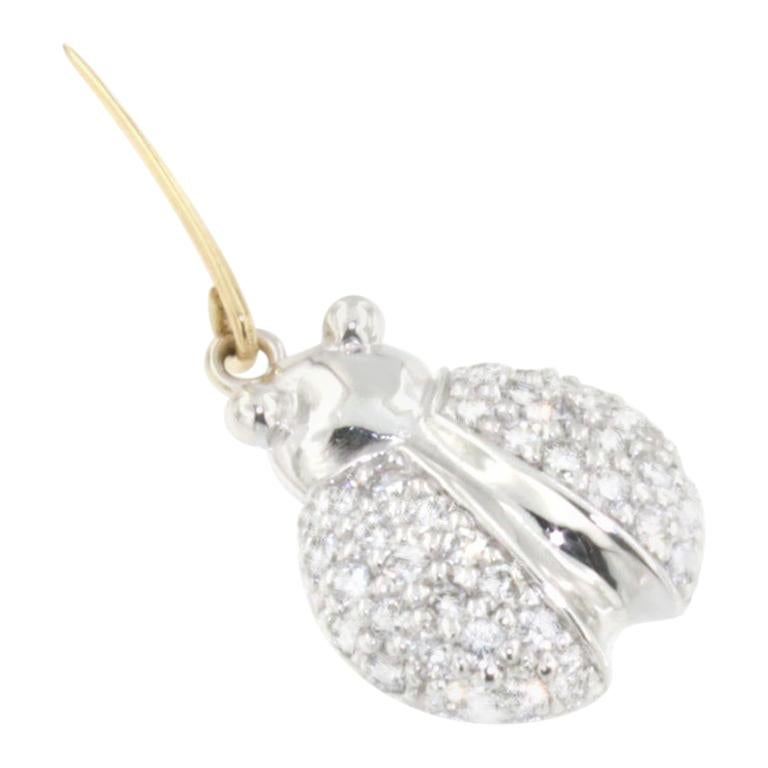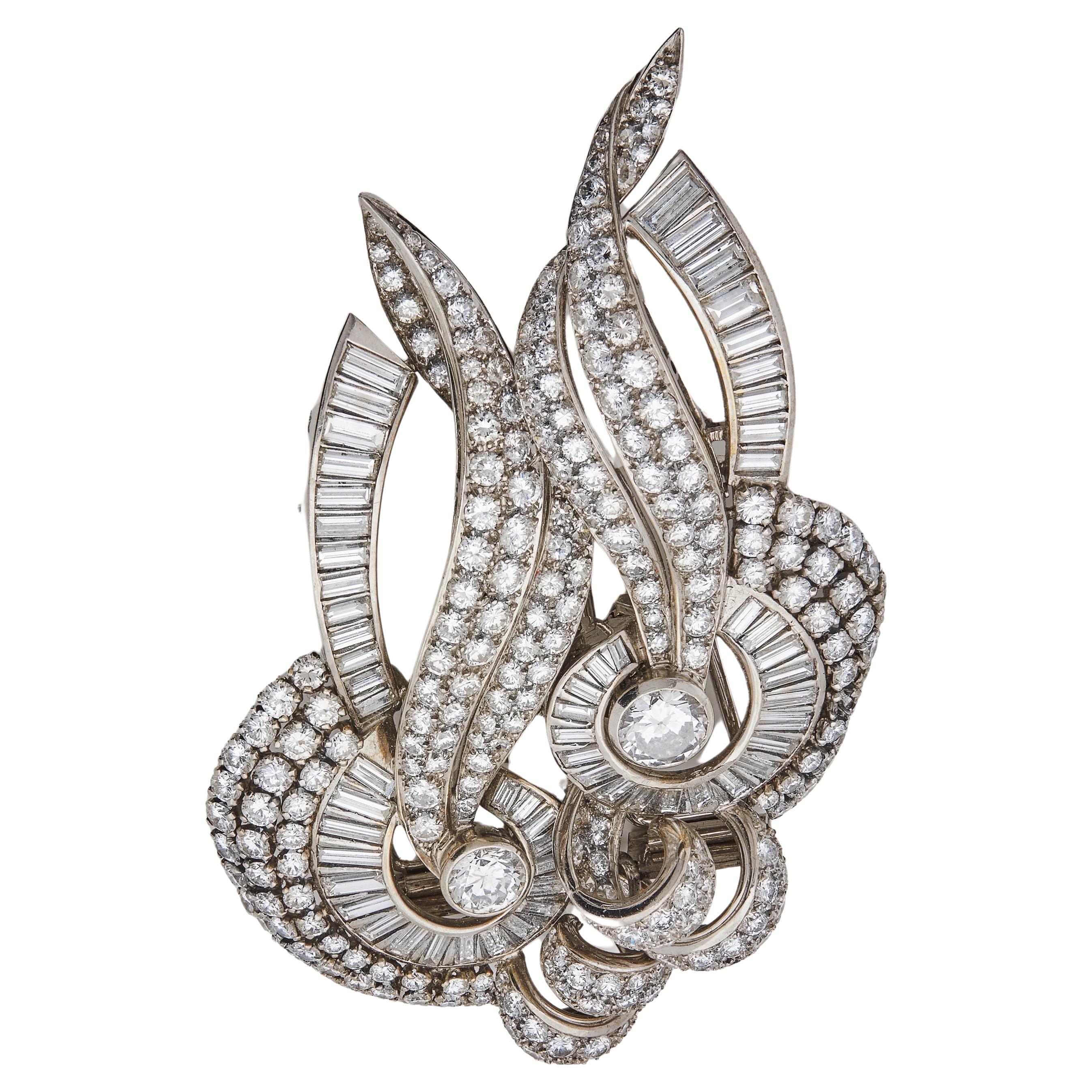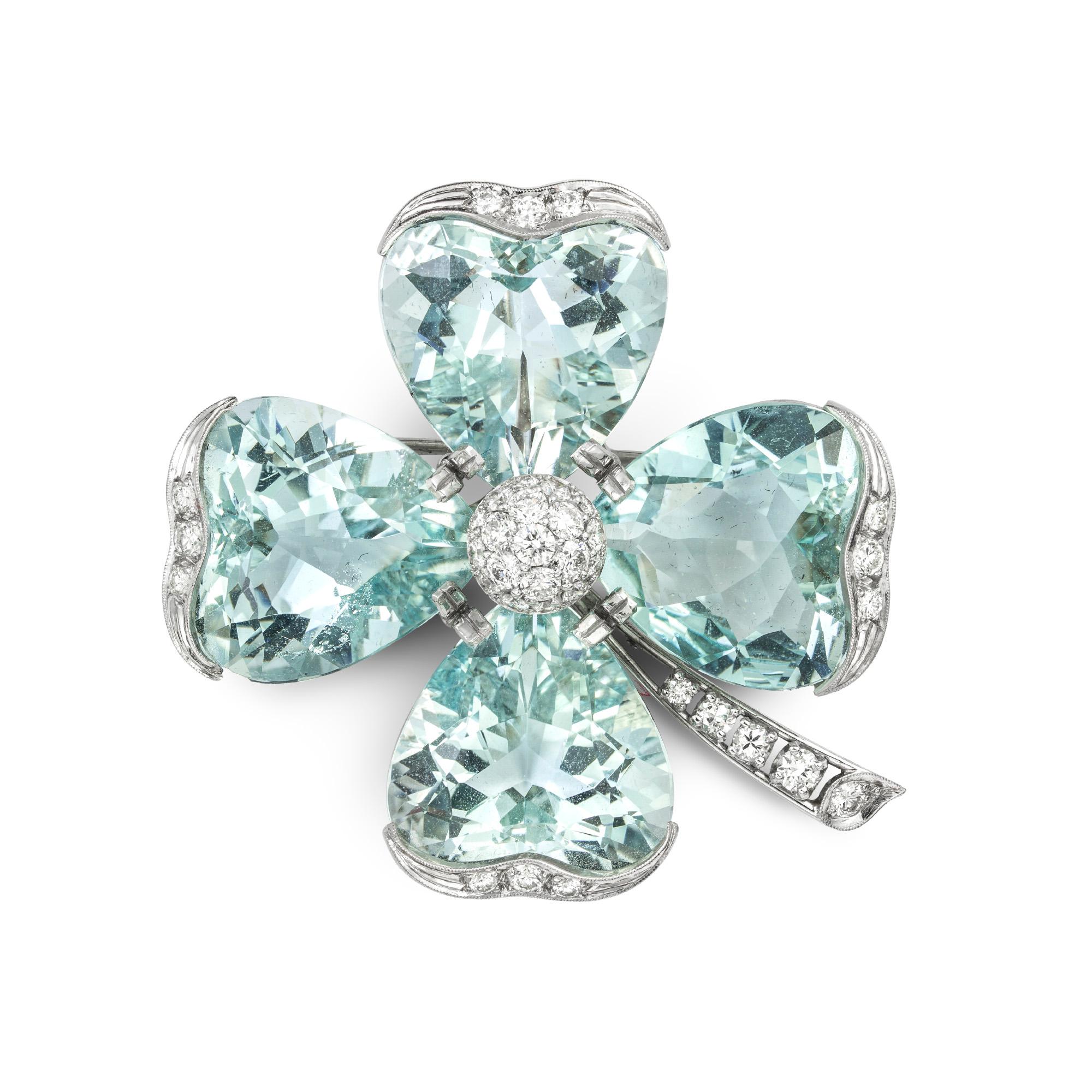Items Similar to Artist BertoiaStyle Hammered SterlingSilver SquiggleSpiral UndulatingWire Brooch
Want more images or videos?
Request additional images or videos from the seller
1 of 6
Artist BertoiaStyle Hammered SterlingSilver SquiggleSpiral UndulatingWire Brooch
About the Item
This modern mid-century abstract three-dimensional unsigned brooch is a single hand-hammered sterling-silver wire that was shaped by an artist into an undulating squiggle that ends in a spiral, which forms a c-clasp for self-closure while its other end is a sharpened pin. Its simple curvilinear design, partly flattened areas, elegance and decades-old patina resemble similarly-sized brooches by the pioneers of American studio jewelry Alexander Calder, Art Smith and Harry Bertoia, whose unique dramatic biomorphic works were likewise created with minimal materials and tools.
While only early works with sterling silver by Smith have been recognized without his script signature, Calder and Bertoia did not sign most of their jewelry. Only limited-edition jewelry reproduced by the Harry Bertoia Foundation includes a branded signature.
According to the Foundation, most of Bertoia's original jewelry since 1934--which he created with whatever metal materials he could afford--was made while he was a student at Cranbrook Academy of Art until 1943. Significant to our brooch, many of his early brooches have a sharpened pin and hand-tooled bent wire substituting for a hinge and clasp, such as the one of approximately 2-inch size in the Foundation archive dated 1939-1943 (D.JE.25), as well as the partly-hammered wire squiggle clasp on the sterling silver necklace dated 1940-1943 (D.JE.50) that includes a closeup photo showing great likeness to our brooch shape and tool marks. While at Cranbrook, he also used the distinctive squiggle shape to style a figurative snake as a more complex silver brooch.
Prior to focusing on furniture and sculpture, Bertoia fabricated metal jewelry that included not only bent and hammered wire but also forged pieces with rivets and/or clamps that characteristically link multiple cut or cast parts often with kinetic properties. Of the hundreds of one-of-a-kind works of jewelry attributed to Bertoia (1915-1978), the majority were made while he was at Cranbrook, which extended to his post-graduate work there as a metal-smithing instructor.
- Metal:Sterling Silver
- Weight:3 g
- Dimensions:Height: 1.25 in (31.75 mm)Width: 0.07 in (1.78 mm)Depth: 0.25 in (6.35 mm)Length: 2 in (50.8 mm)
- Style:Modern
- Place of Origin:United States
- Period:Early 20th Century
- Date of Manufacture:1930s-1940s
- Condition:Wear consistent with age and use.
- Seller Location:Chicago, IL
- Reference Number:1stDibs: LU3244218145472
About the Seller
5.0
Vetted Seller
These experienced sellers undergo a comprehensive evaluation by our team of in-house experts.
Established in 2012
1stDibs seller since 2022
9 sales on 1stDibs
Typical response time: 1 hour
- ShippingRetrieving quote...Ships From: North Adams, MA
- Return PolicyA return for this item may be initiated within 1 day of delivery.
More From This SellerView All
- MiriamHaskell WWII FrankHess PurpleGlassFlowersGoldLeaves WiredPlasticBackBroochBy Frank Hess for Miriam HaskellLocated in Chicago, ILBeginning in 1939, Miriam Haskell asked her first designer Frank Hess to sparingly use metal in the costume-jewelry collections during WWII while war materials were needed. So their ...Category
Vintage 1940s American Baroque Revival Brooches
MaterialsMixed Metal
- Cruciform NielloInlay FleurDeLys GiltEngravedCopperAlloy Heraldry Brooch PendantLocated in Chicago, ILThis 15th-Century period or older gilt copper and silver alloy amulet with niello inlay is an elaborately engraved three-dimensional brooch and pendant, which demonstrates the epitome of miniature decorative nielli in the early Renaissance by European goldsmiths of small cruciform or quatrefoil objects with heraldry symbols. Beyond a dense array of engraved radiant-light, cloud and star motifs with punchwork, it features a 10mm fine black crested staff that is the Christian symbol for the Holy Trinity. This intricate engraving with niello has fleur-de-lys elements, like a French or Florentine coat-of-arms or monogram used to identify noble families or a significant person like a king. It tops a 5mm bar, which is bracketed by 10mm peaked bars that form a cross. When worn, it is positioned horizontally like an elongated barbed quatrefoil. The bars may be concealing a relic such as wood, while it is not clear how these pieces are attached to the front. As a symbol of French conversion to Christianity, the French King Louis in the 12th Century made a fleur-de-lys element of the Holy Trinity vector the official emblem of his royal authority on shields. Later, English kings adopted it when claiming the French throne. By the 14th Century, the fleur-de-lys was used in family insignia that was sewn onto a knight's coat-of-mail surcoat. This coat-of-arms insignia could identify them if found on a battlefield. The Met Cloisters museum collection includes a similarly sized mid-15th Century French gold brooch...Category
Antique 15th Century and Earlier European Renaissance Brooches
MaterialsGilt Metal, Mixed Metal, Niello, Silver, Copper
- Couture CocoChanel Byzantine ThePurpleHeart PearlAmethystQuartz GoldMedallionBy ChanelLocated in Chicago, ILDuring the ArtDeco period when Gabriel "Coco" Chanel was at her peak as a Parisian couture fashion-designer in the early 1930s, this antique one-of-a-kind handcrafted gem-fringed and gilt-chain medallion brooch with trombone clasp was commissioned to accessorize one of her clothing designs. Marked only "FRANCE" like some early 1930s Chanel couture jewelry (without a brand stamp until the 1950s), its artistic origin is most likely from ornate organic-form sketches by her favorite parurer Fulco di Verdura. The Sicilian duke began creating fabric patterns for Chanel in 1927, which shortly expanded to fine jewelry beginning with custom pieces for herself. These include the iconic Byzantine-influenced gem-adorned cuffs referencing the Maltese military-cross, which the French designer can often be seen wearing in circa-1930s photos. This bright yellow-gold brooch suits goldsmith Verdura's early anti-Art-Deco aesthetic that was considered a radical departure from 1920s silver-tone jewelry, which otherwise featured linear geometric designs or figurative representation. The softly-shaped deconstructed gem-bouquet mixes amethyst and rose-quartz beads with natural Keshi pearls and intricate tiny gilt leaves, which are wired to a Baroque-motif open-work frame that dangles another gem surrounded by a thick gilt-rope halo. Notably, Verdura is credited with re-introducing since Victorian times the rope motif to jewelry. Since 1930, Verdura's unique style was influenced by travels with Chanel to explore Byzantine art, Baroque architecture, and exotic flora-and-fauna among his native Italian aristocratic estate. The legendary fashion-editor Diane Vreeland and American entertainment-stars were among the first Chanel clients to acquire couture real-gem-adorned jewelry made by Verdura, while one of the two brooches treasured by Vreeland was titled "Theodora". See our photo of the Byzantine mosaic of Empress Theodora, whose image wearing many teardrop pearls above her chest and surrounded by a golden halo seems to be the inspiration for this brooch. As one of the most important modern-design collaborations, Chanel's close relationship with Verdura lasted largely-undocumented years in Paris, until he launched his first outside jewelry venture with a Hollywood designer-boutique after emigrating to the United States in 1934. By 1939 as a financially-backed in-demand goldsmith, he founded the namesake jewelry-company Verdura in NYC. After he retired in 1973, the brand continued to operate without him with different owners. Given the duo's designs that played with historic and military references, Chanel's couture commission for this purple medallion may have been sparked in the early 1930s when the internationally-new...Category
Vintage 1930s French Brooches
MaterialsAmethyst, Pearl, Quartz, Gold, Gilt Metal, Yellow Gold
- 1941 ChanelRelevant American Reinad ArtDecoStyle Silver PolkaDot LargeBow BroochBy ReinadLocated in Chicago, ILIn Spring 1941 after French fashion couturier Gabriel "Coco" Chanel had stopped production of her clothing designs while she remained in Europe during the WWII era, the decades-old American costume-jewelry company Reinad began imprinting pieces in its new retail line, Chanel Novelty Co, with the script signature "Chanel". As this was prior to the use of the sans-serif capital-letter signature "CHANEL" on French-made jewelry that was commissioned by the Parisian designer, as well as before U.S.-copyright protection began in 1955, the House of Chanel that was mostly owned by the Jewish Wertheimer family of venture capitalists (who remarkably still produced Parfums CHANEL and French-vineyard wine via legal proxy while they lived in asylum in The States during the war) filed a U.S. lawsuit to demand that Reinad halt the use of its founder's famous last name. As the Werthheimers' quickly won, Reinad only produced the single seasonal collection stamped with the French brand name, and subsequently only imprinted its company name as the sans-serif capital-letter signature "REINAD" without a copyright symbol, which was different that its prior signatures dating back to its founding in 1922. When Chanel herself resumed French-made fashion production in Paris in 1953 (with Werthheimer support leading to their acquisition of all rights to her name despite her post-war eight-year exile in Switzerland due to close association with Nazis), for the first time all of her creations were signed "CHANEL" like the original packaging of the exceedingly profitable "No.5" perfume. While Reinad continued to produced costume jewelry until 1954, in the last decade of this business, the U.S. company continued to try to appeal to potential Chanel buyers by at least making Chanel-style designs. As such, owning an attractive and well-made Reinad piece can be considered a useful investment in fashion history as evidence of a little-known turning-point involving the most famous ongoing luxury-fashion business Chanel, as well as of the impact of that legal judgement had on advancing U.S. design protection for brands that later used the copyright symbol. Like early ArtDeco-style oversized heavy metallic costume jewelry by Chanel, this three-dimensional monochrome silver-alloy polkadot bow brooch imitates a pale polkadot-textured ribbon. Notably, while high-quality ribbon for styling hair or decorating clothing in a non-functional way was still an expensive accessory...Category
Vintage 1940s American Art Deco Brooches
MaterialsRhodium, Silver, Base Metal
- Black Tahitian Pearl Dutch DroogDesign 1998 Unique ThirdNipple GoldDisk BroochBy Artistian MadeLocated in Chicago, ILIn the 1990s when the Dutch collective Droog introduced international leaders of late 20th-Century functional art such as Ron Arad, Marcel Wanders, Jurgen Bey, Hella Jongerius, and Tejo Remy, the Netherlands-based brand was one of the most successful producers of conceptual design. The collaboration was co-founded in 1993 in Amsterdam by the jewelry and product designer Gijs Bakker (b. 1942), who commissioned his protege French artist Frederic Braham in 1998 to create this one-of-a-kind brooch for his young Droog-represented jewelry line "Chi ha paura...?". The Italian phrase means "who is afraid of?". This natural satin-lustre South Sea black-Tahitian 15 x 10 mm baroque thick-nacred pearl, which is bezel-set in oxidized sterling on a sharp silver stud for push-back fastening as a lapel or tie pin, is surrounded by a removable textured gold disk brooch with the Chiapaura maker's mark, artist's signature, abbreviated year and assay symbol. Notably, while farmed pearls from this French-Polynesian region are scarce, it is rarer to find one over 12mm. This dark gray one is also exceptional for its desirable secondary tone of peacock green with minimal surface imperfections. From normal use, the unseen back of the disk is missing chips of ecru enamel where it contacts the fastening knob. This reveals that the disk is solid gold. Like other functional conceptual design represented by Droog, the brooch is more than a beautiful piece of fine jewelry featuring multiple contrasting elements, as it could be a provocative "third nipple" if worn on a tie or scarf. Given the Dutch origin of the brand, we recall the famous 15th-Century oil-painting by Johannes Vermeer, known as "Girl with a Pearl Earring". Who is afraid of girl or boy with a third nipple? We acquired this brooch from a jewelry collector who had purchased it from the Italian gallery...Category
1990s Dutch Artist Brooches
MaterialsBlack Pearl, South Sea Pearl, Pearl, Gold, Silver, Mixed Metal, Sterling...
- Antique FabergeStyle 3AquamarineCabochons 4GreyDiamonds BezelSet Platinum BroochLocated in Chicago, ILThis antique Victorian platinum filigree bar-brooch or tie-pin from the Edwardian period in a Faberge style features bezel settings with three square-cut 10mm sugarloaf aquamarine ca...Category
Antique Early 1900s European Edwardian Brooches
MaterialsDiamond, Aquamarine, Black Diamond, Platinum
You May Also Like
- Rose Gold Floral Brooch with Thirty One Diamonds and Emerald by ArtistBy Polya Medvedeva JewelleryLocated in Berlin, DEThis contemporary Peony Petal floral brooch is in 18 karat rose gold with 31 round natural diamonds, VS, F-G, and natural octagon cut emerald. The sculptural design adds the extra hi...Category
21st Century and Contemporary German Contemporary Brooches
MaterialsWhite Diamond, Emerald, Diamond, Beryl, Yellow Gold, White Gold, Rose Go...
- White Gold Contemporary Floral Brooch with Diamonds and EmeraldBy Polya Medvedeva JewelleryLocated in Berlin, DEThis contemporary Peony Petal floral brooch is in 18 karat white gold with 31 round natural diamonds, VS, F-G, and natural octagon cut emerald. The sculptural design adds the extra h...Category
21st Century and Contemporary German Contemporary Brooches
MaterialsEmerald, Beryl, White Diamond, Diamond, Yellow Gold, White Gold, Rose Go...
- Brooch 1940 in 18 Karat White Gold and 7 Carat of DiamondsLocated in Paris, FRExceptional Brooch Knot around 1940-1950 in 18 kt white Gold and Diamonds. Vibrant Knot shape with three articulated flexible Stems in the Center, one set with 10 baguette-cut Diamo...Category
Vintage 1940s French Art Deco Brooches
MaterialsDiamond, 18k Gold, White Gold
- 18 Karat White Gold with White Diamonds BroochLocated in GALLARATE, ITElegant Talisman ! Stanoppi takes care of you ! Protect yourself with style. Talisman applied on a 100% pure cotton mask with protective filter or you can put the brooch in your jack...Category
21st Century and Contemporary Italian Modern Brooches
MaterialsDiamond, White Diamond, White Gold, Gold, 18k Gold
- Vintage Diamond BroochLocated in New York, NYCommand attention in this exquisite diamond brooch from the Jewels Aficionado antique collection. Outfitted with a whopping 20.40 carats of diamonds set in platinum, the brooch mixes...Category
Vintage 1960s Brooches
MaterialsDiamond, Platinum
- Vintage Aquamarine and Diamond Flower Head BroochLocated in London, GBA vintage aquamarine and diamond flower head brooch, the brooch with round brilliant-cut diamond set domed centre surrounded by four heart sh...Category
Vintage 1950s Modern Brooches
MaterialsAquamarine, Diamond
Recently Viewed
View AllMore Ways To Browse
Antique Metal Jewellery
Antique Metal Jewelry
Hammered Jewellery
Jewellery Tools Used
Jewelry Tools Used
American Studio Jewelry
Antique Jewelry Brands
1940s American Jewelry
Art Smith Jewelry
Multiples Brooch
Sterling Silver Brooch Used
Abstract Brooch
Brooch Alexander
Midcentury Modern Studio Jewelry
Mid Century Sterling Brooch
Antique Jewellery Tools
Antique Jewelry Tools
Antique 1930s Necklace

